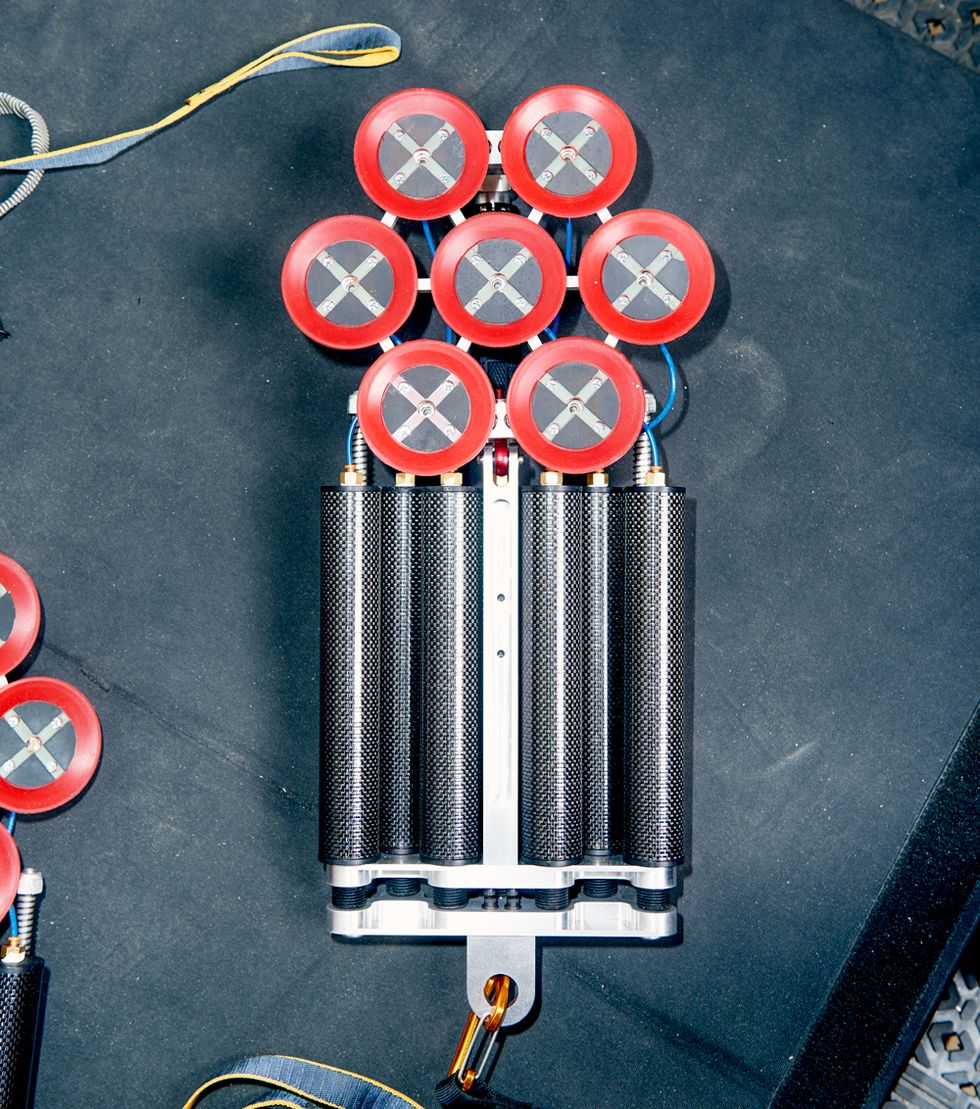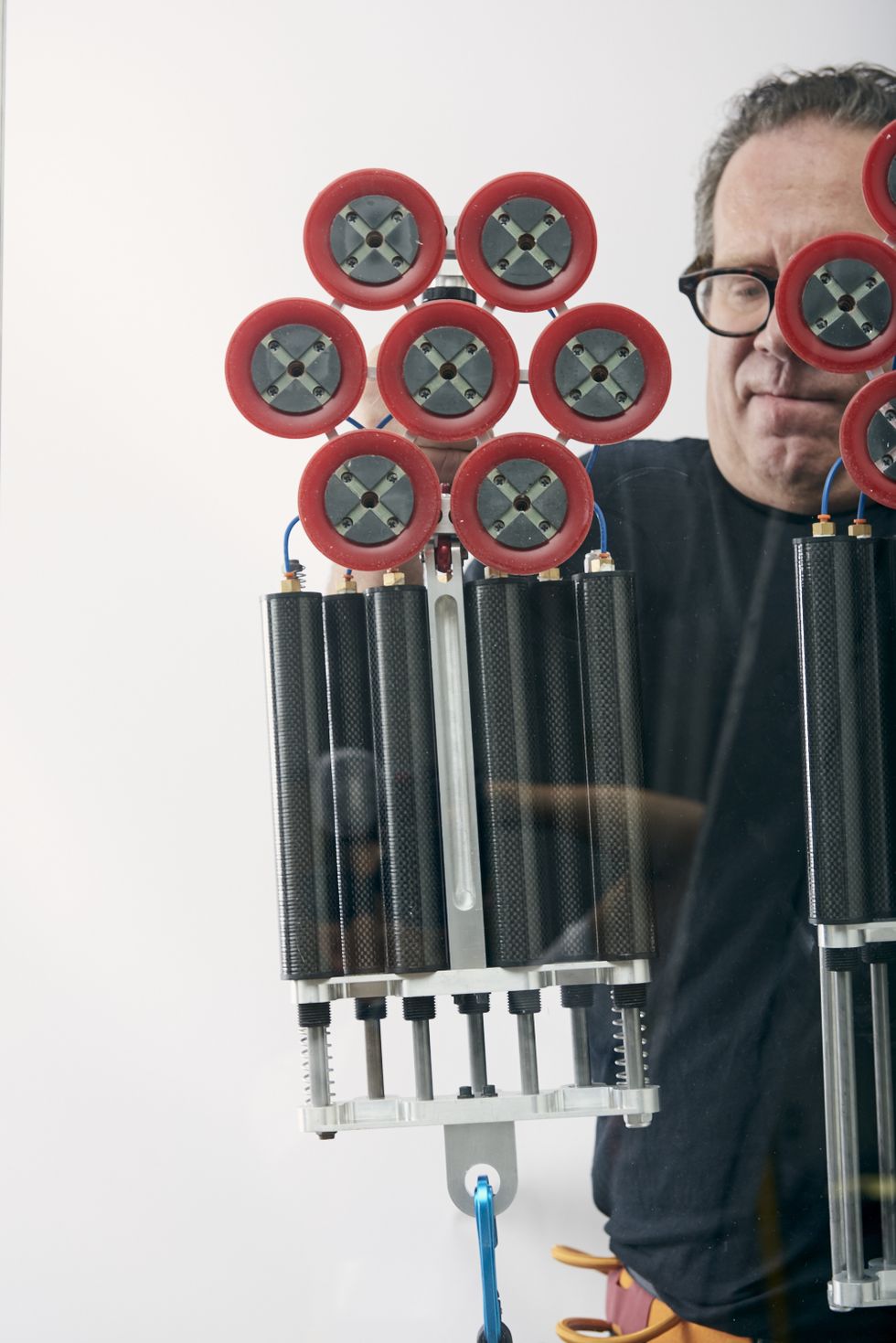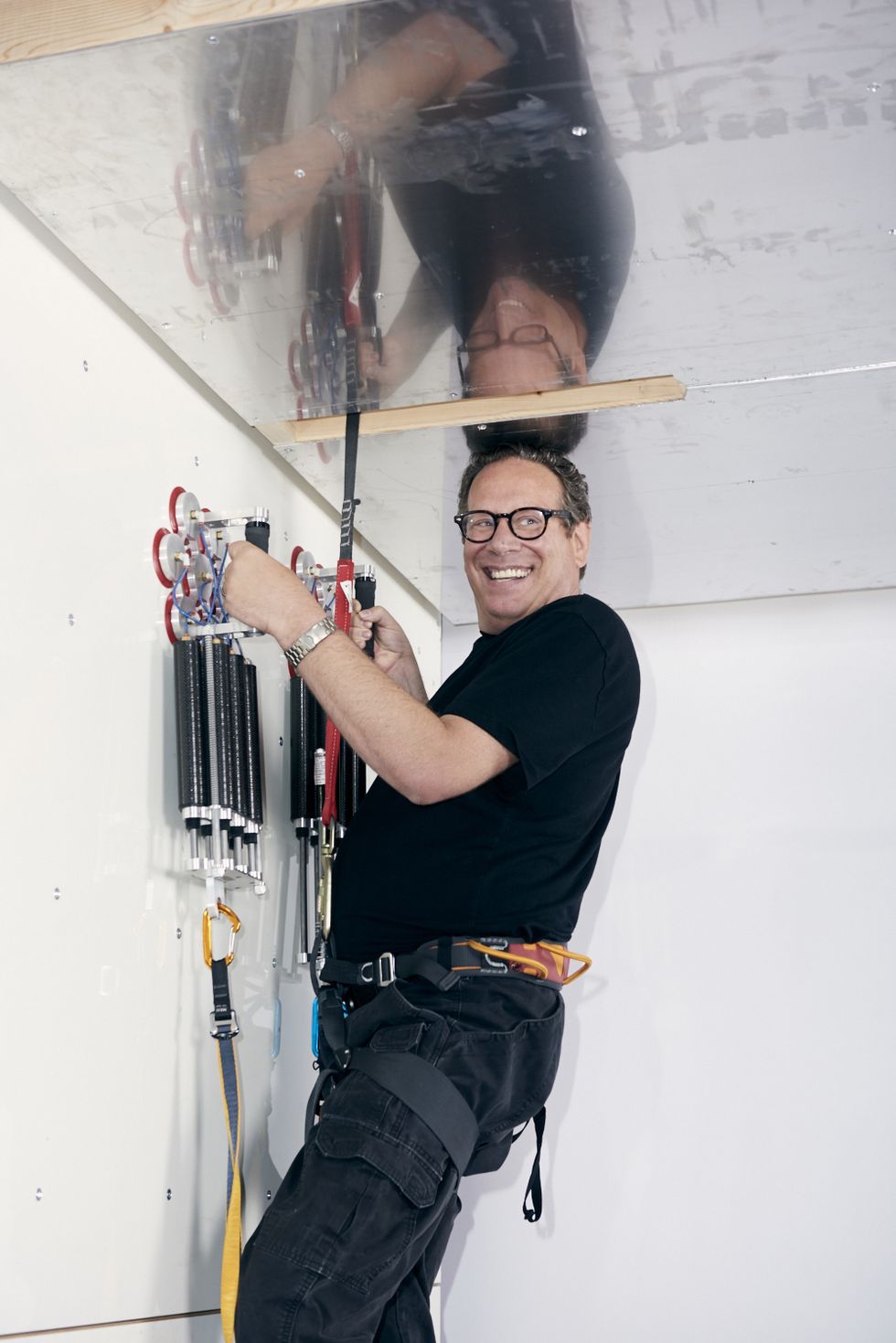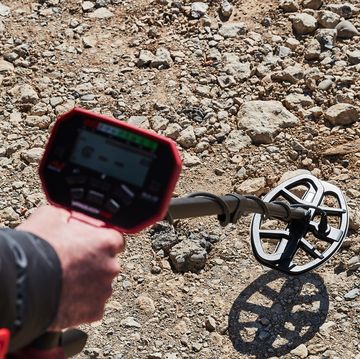I'm dangling near the top of a twenty-foot plate of glass. All two hundred pounds of me. On land, I can't do a single pull-up—not even if you held a doughnut over the bar. But I got up here using my own strength, and if it weren't for my nerves, I wouldn't have broken a sweat. The suction-cup paddles in each of my hands are harnessed to my waist. Stirrups loop around my feet. As I shift my weight off my right leg and onto my left, the pneumatic fingers on the paddle in my right hand release the pressure holding the seven suction cups above them to the wall. My body weight moves to my left leg, pulling down the fingers in the paddle in my left hand. The suction cups of the left paddle push into the wall, forcing microscopic silicone ridges against the glass for maximum surface contact and hold. When I reach the ceiling, I linger, feeling more than a little like a superhero, but also wondering how I'm going to get down.
Those loops around my feet are very important. If I lean too far back or to the side—the vector of my weight no longer directly beneath the paddle—that suction will quickly release. I know this because it's exactly what I do. In my excitement to move from the glass wall and try the device on a painted surface, I stretch the paddles too far apart. With my foot and my weight no longer aligned below the paddles, I slide down the wall and crash to the ground in a tangle of devices and—luckily—backup ropes.
The idea for this equipment—called Z-Man, named for the third-dimensional, or Z axis—came about ten years ago at DARPA, a group whose mission is to protect the defense establishment and the nation from technological surprise. Two program managers, John Main and Morley Stone, were discussing the urban battlefield. "We were in the thick of the Iraq war and a lot of activities taking place were urban, and the urban high ground is the top of buildings," says Main. "We were trying to get people safely to the top of a building." A study at Stanford suggested that mimicking gecko skin could help small robots climb, and Stone and Main wondered if the same type of technology would work for humans. "Stone shrugged his shoulders and said, 'I think so,' " Main says. "And I shrugged my shoulders and said, 'I think so.' That was the genesis of the whole program."
For the past decade, DARPA Z-Man scientists have struggled with a challenge that has perplexed scientists since Aristotle: How the hell does a gecko run up and down a tree? And how do we replicate that ability on humans? There were many theories and, in desperate times, the suggestion of magic. But "it's nothing like magic," Main says. "If you look at the toe of a gecko, it's got millions and millions of tiny 'hairs.' These little protrusions are very flexible and very, very strong. The gecko gets all of those hairs in very close contact with the wall he's climbing or the ceiling he's hanging from, and they all hold him up." The phenomenon is based on a physics principle called van der Waals forces, in which atoms in very close contact create a temporary attraction. So they understood how the sticking-to-the-wall part happened. Next they had to figure out the actual movement—to translate the mechanics of how the gecko dragged its upper and lower feet together to maintain the van der Waals attraction, while also being able to move freely. Even when upside down.
Things got frustrating. Whatever the scientists learned, whatever new approaches they took, the results didn't seem applicable to human use. "This program would have been over in two years if we could have done exactly what the gecko does," Main says. "But what the gecko does that humans can't do is flex between two contact points all the time. People can't get their hand on the wall and their foot on the wall, and put a lot of force into sliding them toward each other." Plus, there are all types of walls. What works on glass may not work on brick, which may not work on metal.
That frustration was felt at Draper Labs in Cambridge, Massachusetts, too. Draper is a not-for-profit engineering research and development organization that does a lot of highly classified work for DARPA and other branches of the government. It's staffed with brilliant scientists, most of whom have no idea what their colleagues are doing in the room next door. In one of those rooms, David Carter and Will McFarland had a minor breakthrough. They had considered creating hand and foot paddles with a silicone "skin" made with nano-ridges, just like a gecko's. But it still wouldn't be strong enough to hold most people up on a wall. So they shifted their attention to another animal they'd been studying at the same time: spiders. In watching the insects climb brick, they discovered an ingenious array of fishhook spines, tightly assembled with the hooks facing downward. Those hooks grab into the brick face without slipping, as long as the spider's—or the climber's—body weight is suspended directly below them. Soon they developed hand paddles with tiny metal spines. And those paddles worked, allowing you to climb any wall, just as long as that wall was brick. This led researchers to also experiment with steel and iron.
The obvious material was magnets, and the two men created paddles that locked and unlocked from the wall by shifting a handle on the paddle up or down. Strap your legs in, and you could climb any surface, just as long as it was metal. The uses were immediately apparent. "There are a lot of steel structures like oil rigs that people needed safety and climbing equipment to manage," Main says. The magnetic paddles, which are depicted on the cover of this issue, have been licensed to a high-end military-supply company, Atlas Devices, and the technology is rumored to be already in use by special-operations forces to climb onto ships, tankers, and oil platforms.
So now scientists had a way to climb brick and a way to climb metal. But they had nothing for smooth, non-magnetic walls. At this point, Main had cycled out of DARPA, working for a startup for seven years, and returned. When he got back, the mood was worse than when he'd left. Much worse. "There's a required stage in every technology project," Main says. "That's the despair stage. That took place when we had been working on Z-Man for quite some time but were in a rut. The idea of using suction came about because of frustration at being in that rut." Despair, in this case, was a good thing. "That's when the creativity and drive kicks in, and something terrific happens."
The problem with the nano-ridged silicone skin Carter and McFarland had pictured before was that the surface couldn't get close enough to the walls to activate the van der Waals forces. They'd tried simple suction cups, too, but those could only hold climbers in place. There was no way to release and reaffix them to actually climb. Under Carter's leadership, the team at Draper were inspired to combine the gecko skin and suction cups with leg power. Their new paddle consisted of synthetic gecko skin layered inside suction cups. To increase the efficiency of those suction cups, they attached foot stirrups to a series of pistons. When the foot stirrups are depressed, the pistons evacuate extra air inside the suction cups. This smashes the nano-ridges against the wall surface, activating the van der Waals forces. And when the suction is released by lifting the climber's weight off of the stirrup, the paddle can be easily moved elsewhere. Equally impressive is the cost: Carter and his team estimate that each pair will cost only $3,000 to $5,000.
Although it takes three types of paddles to conquer any surface instead of one, Main is confident that the technology will one day be combined into a single device. Like all military contractors, DARPA is cagey about if, where, and how the Z-Man has been deployed in the field. "Use your imagination" is all that Main will say. Which is probably the same advice he gave when he issued the Z-Man challenge ten years ago.
*This article originally appeared in the December 2016 /January 2017 issue of Popular Mechanics.
















